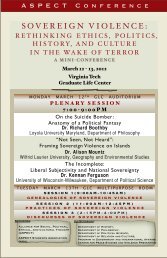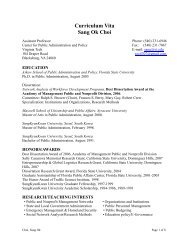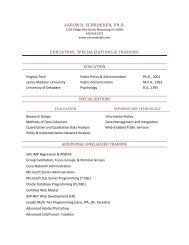1 Towards a Critical Social Theory of Philanthropy in an Era of ...
1 Towards a Critical Social Theory of Philanthropy in an Era of ...
1 Towards a Critical Social Theory of Philanthropy in an Era of ...
Create successful ePaper yourself
Turn your PDF publications into a flip-book with our unique Google optimized e-Paper software.
authored is falsely understood as perm<strong>an</strong>ent. Therefore when money is used to control the<br />
distribution <strong>of</strong> resources, resources are distributed as social policy accord<strong>in</strong>g to ideology. This is<br />
dist<strong>in</strong>ctly exclusionary because social policy comes to be dictated by pr<strong>of</strong>it <strong>in</strong> the h<strong>an</strong>ds <strong>of</strong> the<br />
few who are able to amass wealth, further marg<strong>in</strong>aliz<strong>in</strong>g those who would ch<strong>an</strong>ge their position<br />
<strong>in</strong> society for the better. <strong>Social</strong> policy that is dependent upon the ideological text <strong>of</strong><br />
phil<strong>an</strong>thropy’s money legitimates the very system that it is assumed to oppose. It legitimates<br />
pr<strong>of</strong>it’s creation <strong>of</strong> marg<strong>in</strong>ality by appear<strong>in</strong>g to be benevolence rather th<strong>an</strong> pr<strong>of</strong>it. What we call<br />
phil<strong>an</strong>thropic action actually depends on the social system rema<strong>in</strong><strong>in</strong>g the same – phil<strong>an</strong>thropic<br />
action would cease to be necessary if the system ch<strong>an</strong>ged such that suffer<strong>in</strong>g were drastically<br />
reduced.<br />
Fast capitalism (1989) expla<strong>in</strong>s that boundaries are blurred <strong>in</strong> the <strong>in</strong>terest <strong>of</strong> structur<strong>in</strong>g<br />
the social world: “a positivist culture swallows textuality but then expels it <strong>in</strong>to the exterior<br />
world. As a text itself, these dispersed versions exercise a power over ‘readers’ who live them as<br />
unalterable versions <strong>of</strong> the unalterable” (24). Thus, phil<strong>an</strong>thropy c<strong>an</strong> be understood as blurr<strong>in</strong>g<br />
the boundary between state <strong>an</strong>d society through the medium <strong>of</strong> “govern<strong>an</strong>ce,” which is deradicalized<br />
through uncritical read<strong>in</strong>gs <strong>of</strong> the assumption that power c<strong>an</strong> be evenly dispersed <strong>an</strong>d<br />
thus ready accept<strong>an</strong>ce <strong>of</strong> the impossibility <strong>of</strong> do<strong>in</strong>g th<strong>in</strong>gs differently.<br />
Conclusion: Refram<strong>in</strong>g Govern<strong>an</strong>ce <strong>an</strong>d <strong>Phil<strong>an</strong>thropy</strong><br />
Govern<strong>an</strong>ce disguises the struggle over social problems at is frames problems as<br />
adm<strong>in</strong>istrative rather th<strong>an</strong> as systemic. The problem is not the cure, but the cause. We have<br />
argued elsewhere (Nickel & Eikenberry <strong>in</strong> press) that it is a non-sequitur to treat social problems<br />
as though they result from failed attempts to m<strong>an</strong>age them. The problems that a “faith-based<br />
17






